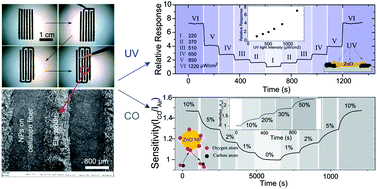Sketching functional, ubiquitous ZnO nano-sensors on paper
Abstract
We report the fabrication of functional nanoelectronic sensors on regular copy paper by simply sketching electrode lines and painting the resistively sensing nanostructured film using synthesized zinc oxide (ZnO) nanoparticle (NP) inks. A repeatable three orders of magnitude increase in conductance is demonstrated when the sensors are exposed to 30 s long 1220 μW cm−2 ultra-violet (UV) irradiation pulses in the dark with a 6 s and 3 s rise and recovery times, respectively. Moreover, a 200% increase in current is also observed at room temperature, when these sensors are exposed to successive pulses of pure CO. The sensors exhibit a fast response to variations in concentration of CO as small as a 1% volume change. The sensitivity to CO concentration can be significantly improved by using UV irradiation. This work shows that sketching of metal oxide nanostructures with controlled nanoscale properties on paper can be employed for fabrication of accurate and reliable sensors that can find applications in ubiquitous environmental sensing, electronic paper, wearable electronics, and sensor networks.


 Please wait while we load your content...
Please wait while we load your content...